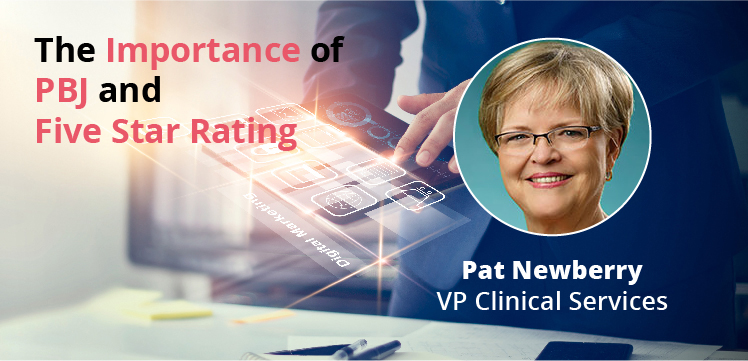 Section 6106 of the Affordable Care Act (ACA) requires facilities to electronically submit direct care staffing, including agency and contract staff and census information on a quarterly basis. The Centers for Medicare and Medicaid Services (CMS) has named their reporting system the Payroll-Based Journal (PBJ).
Section 6106 of the Affordable Care Act (ACA) requires facilities to electronically submit direct care staffing, including agency and contract staff and census information on a quarterly basis. The Centers for Medicare and Medicaid Services (CMS) has named their reporting system the Payroll-Based Journal (PBJ).
CMS reduced the ratings of nearly 1,400 nursing homes for failure to provide adequate staffing or failure to provide the required payroll data, according to U.S. News & World report. Careful and accurate PBJ reporting is a critical component of facility staffing efforts which translates into star ratings. CMS announced stricter standards for nursing homes which includes smaller windows for staffing penalties and new ratings for short-term and long-term stays.
What You Need to Know:

- CMS will get tougher on all three foundation metrics: survey, quality, and staffing
- Staffing levels seem to be at the forefront of focus of the Five Star Rating System
- CMS will give a one-star staffing rating to facilities that reported four or more days in a quarter without a registered nurse on premise.
- Inaccurate reporting of nursing coverage not only has been exposed, but the ramifications have caused the prior standard of 7 days or more without a registered nurse to move the pendulum to 4 days or more.
What Does This Mean to Your Facility?
It means that staffing standards have caused many skilled nursing facilities to take a direct hit on their star ratings already. It means that the new measures will cause many facilities to struggle to procure an above average rating. While superlative provision of quality patient care and staffing must be paramount in any facility and is directly relational to optimal patient outcomes, poor ratings will ultimately be critical to your organizations on-going success.
Five Things to Maintain and Increase Your Star Rating with PBJ:
- VIGILENCE: Check your Five-Star Rating on Nursing Home Compare. The old saying what you don’t know can hurt you is always true! Checking and confirming NHC staffing numbers match the 5 Star Report to ensure there is no error is good practice
- BE IN THE KNOW: Submissions are to be received by the end of the 45th calendar day (11:59 PM Eastern Standard Time) after the last day in each fiscal quarter to be considered timely.
- DETAILS: Focused detailed tracking of additional information about staffing such as turnover, tenure and hours worked for everyone is essential
- FORMULATE performance processes that address the PBJ requirements of submitting information in one of the two ways allowed: manually entered into the PBJ website, or imported in a specialized XML data format
- Have the required data readily available:
- Direct Care Staff:
- Employee ID
- Hire date
- Termination date
- Staff Hours:
- Date
- Hours
- Job Title Code
- Pay Type Code
- Census Data: Report census for three individual days during the quarter: the last day of each month, which must include the number of residents whose primary payers are Medicaid, Medicare or other
- Direct Care Staff:
Six Important Measures to Retain Staff
Maintain experienced nursing staff who are valued and appreciated.
Lower staff turnover rates lead to better care at lower costs, few long-term care nurses or administrators would argue that statement. PBJ ratings and quality outcomes put a greater burden on facilities to retain their staff. Perhaps the greatest opportunity for successful star ratings and quality patient outcomes is to maintain experienced nursing staff who are valued and appreciated.
Strategic key initiatives to retain important staff:
- Retention: Provide mentorship of new hires with an experienced nurse. Retention begins day one.
- Consider a lighter patient load for a designated period of new hires.
- Culture is Important: Provide an open environment that fosters a supportive culture of education, growth and recognition of excellence.
- Opportunity: Provide open opportunities for staff to excel and climb the internal ladder.
- Scheduling: Provide a culture of work life balance for staff. Fair scheduling goes a long way.
- Reward Retention: Nothing means more to nursing staff then being appreciated and celebrated for making their career their calling. You may have heard the phase “People don’t quit jobs, people quit bosses”. If you are not providing a culture of mutual respect and appreciation, your staff may seek it out elsewhere. Under the CMS PBJ program, facility staffing information submitted each quarter represents the number of hours staff are paid to work each day of that quarter. The new data collection’s goal is to improve the accuracy of public reporting and correlate how facility staffing relates to quality and outcomes. CMS believe that the presence of a registered nurse onsite every day is critical to improving the health and safety of nursing home residents. By focused attention to PBJ reporting, adhering to staffing levels, and establishing a culture for staff retention in your facility, five-star ratings will continue to successfully differentiate your facility, patient outcomes and retain your valued staff.
People don’t quit jobs, people quit bosses.
Along with the volatility of short staffing comes the potential for adverse outcomes such as events that may cause intervals in resident care that can lead to avoidable hospitalizations. While some estimates put as many as 60 percent of rehospitalizations as preventable, it has been recognized that there is a strong correlation to nursing shortages that could contribute to the vicious cycle of gaps in care and potentially avoidable adverse outcomes.

Pat Newberry (PT, MBA, CMAC, RAC-CT) is Vice President of Clinical Services at Team TSI. She has over 20 years' experience with long-term care and CMS. She knows regulations inside and out and is an invaluable member of our team of subject matter experts.
What Do You Think?
Each of our experts keeps apprised of industry developments by reading, communicating with peers and using their knowledge and experience. Our editorials contain interpretation and speculation (that’s what makes them great!) so it’s possible that we got something wrong. Tell us all about it and we just might feature your ideas on this page.
